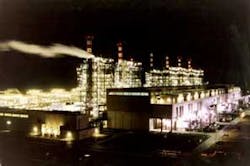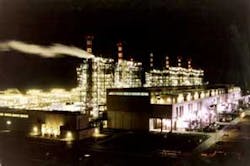Desalination plays key role in sustainable development
By Jacque Andrianne, Félix Alardin
Desalination and wastewater reuse should be considered important factors in sustain-able development strategy, particularly in semi-arid and arid coastal regions, where much of the world population resides.
Water management strategies should make best use of conventional water resources, such as surface water and groundwater reserves, in addition to complementary non-conventional sources - desalination of sea and brackish water, and wastewater reuse.
Improvements in desalination pro-cess design, equipment, membranes and energy sources have made the technology more efficient, reliable and less costly. Consequently, desalination has become a more economically viable water supply alternative, complementing surface water and groundwater reserves.
Multi-stage flash (MSF) process capacities have increased to 17 migd (million imperial gallons per day) while 5-migd units of the MED-VC type (multi-effect distillation - vapour compression) now perform on a commercial basis, bringing down the cost of installed capacity.
Designers made great progress in efficiency. In thermal desalination, heat transfer coefficients are better than before due to adequate material selection and appropriate heat exchangers design. The addition of chemicals controls scale formation better than in past years.
For membrane desalination, manufacturers improved the membrane in terms of productivity, resistance to higher pressure and temperature. More efficient energy devices reduced power consumption by recovering energy from rejected brine still at relatively high pressure.
Several factors have led to higher reliability in desalination plants: materials that prevent corrosion problems; set-up of reliable high-capacity pumps and equipment; longer lifetime of membranes; better pretreatment of raw water to protect membranes, and better trained and skilled operators.
Many countries demand more water and power. Fortunately, combining the production of water and electricity reduces significantly the cost of water production. During the early days of desalination, steam produced by boiler without electricity generation fed thermal desalination plants. Cogeneration processes represent a great milestone in the quest to reduce water production costs. Desalination hybrids - the combination of thermal and membrane processes - achieve further advantages.
In the Gulf region during the winter, electricity surplus produced by a combined power and thermal desalination plant can feed a complementary membrane desalination process. Desalination hybrids improve total efficiency, which can be further enhanced by the following synergy. Heat rejected from the thermal desalination plant results in optimum and near-constant feedwater temperature to the membrane process.
In addition, both thermal MSF and MED processes produce distillate at around 10 ppm to 25 ppm TDS, but a single-stage membrane plant pro-duces product at around 450 ppm TDS so blending could occur to allow reduction in potabilisation and remineralisation costs. This hybrid approach in power and desalination integrated systems facilitates flexibility in production and reduces overall power and water costs.
The desalination hybrid concept also softens seawater through nanofiltration before entering thermal desalination, which reduces scaling and allows higher top brine temperatures that help increase distillate production.
The power and desalination industry faces a great challenge - to reach a target of US$ .02/kwh and US$ .50/m3 by integrating power and desalination systems. Other approaches are being developed to help reach these goals, such as aquifer storage recovery and retrofitting power and desalination facilities.
Seasonal electricity surplus could feed electrically-driven membrane desalination and hybrid desalination systems combined with aquifer storage recovery. The storage and recovery of large volumes of water could lead to downsizing of power and water production facilities, thereby reducing costs. Desalination combined with aquifer storage recovery could increase potable water reserves and improve water quality.
Power and desalination facilities can be retrofitted/upgraded by modifying a conventional boiler that feeds a steam turbine into a combined cycle system and then adding a membrane desalination process to thermal desalination facilities. These upgrades could improve efficiency and reduce costs.
The "waste to water" approach could lower desalinated water production costs. Urban wastes burned in an incinerator produces steam, which in a cogeneration process facilitates electricity production through a turbogenerator to feed a thermal desalination plant. Alternatively, the electricity can power a membrane desalination plant.
Authors' note
Marketing and Sales Manager Jacques Andrianne and International Sales & Project Manager Félix Alardin work for Tractebel Energy Engineering, based in Brussels, Belgium.

